
Proving it The American Provers’ Union Documents Certain Ill Effects
What would induce physicians to ingest mercury to the point of vomiting and to painstakingly note down the effects of imbibing large amounts of cannabis tincture? Alicia Puglionesi explores the history of "proving", the practice of auto-experimentation which forms the cornerstone of homeopathic medicine.
September 4, 2013
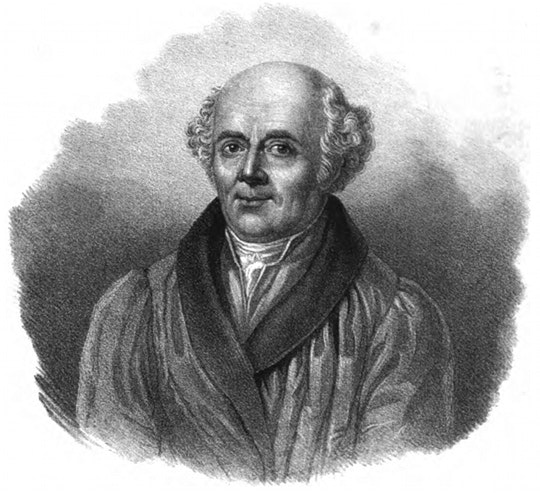 Scroll through the whole page to download all images before printing.
Scroll through the whole page to download all images before printing.Portrait of Samuel Hahnemann featured in Museum für Saechsische Vaterlandskunde (1837) — Source.
Among the many novelties unleashed upon the world by Samuel Hahnemann, the founder of homeopathy, perhaps the most striking is the spectacle of dignified nineteenth-century physicians carefully imbibing graduated amounts of cannabis and attempting to record its effects upon their mental and physical states. Just as you wouldn’t feed dinner guests a dish that you hadn’t sampled, Hahnemann argued, doctors had no right to prescribe their patients remedies that they had not themselves tried. Unfortunately, due to impairment in the record-keeping department, the physicians were “compelled to publish these provings in disjointed symptoms” rather than their usual orderly categories. These hapless explorers of new therapeutic realms belonged to the American Provers’ Union, a group that aimed to attain medical knowledge through firsthand experience. Their records reveal a dimension of medical thinking that has largely disappeared from modern practice: attention to the subjective sensations that link body and mind, physiology and personhood. Built into their quest was a righteous disregard for the considerable hazards of auto-experimentation.
Samuel Hahnemann trained as a physician in late-eighteenth-century Leipzig and Vienna. After three years of medical practice, however, Hahnemann decided to get out of the business and took work translating scientific books (he reportedly mastered Arabic, Chaldaic, and Hebrew as well as the standard Romance languages).
In his later writings, Hahnemann characterized his disillusionment with mainstream medicine as a result of the ineffective and often damaging remedies called for in Western therapeutics, particularly the violence of bloodletting, purging, and other “heroic” treatments in vogue around the turn of the nineteenth century. Many patients were vocally displeased with the disorder unleashed by drugs, like mercury, today regarded as highly toxic, while doctors felt impotent to effect actual cures. Around the time that Hahnemann put down his bloodletting lancet, discontent among patients and practitioners was beginning to manifest in the form of “heterodox” sects that defined themselves against the orthodoxy of medical schools and elite medical practice.
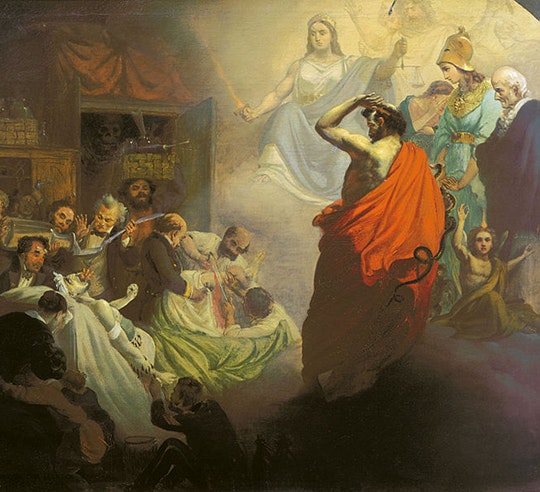 Scroll through the whole page to download all images before printing.
Scroll through the whole page to download all images before printing.Painting from 1857 by Alexander Beydeman depicting the light-filled practise of homeopathy, including a silver-haired Hahnemann, watching disapprovingly on over the horrors wrought by traditional medicine, referred to as Allopathy — Source.
Hahnemann was in many ways a product of this ferment: while translating a medical text that mentioned cinchona bark, a New World plant used to treat malaria, he decided to resolve his doubts about its effectiveness by testing the substance on himself. He observed that cinchona produced effects on his healthy body that mimicked the effects of malaria on a sick body, leading him to theorize that successful remedies worked by treating like with like, fighting disease symptoms with substances that produce those same symptoms in the healthy. Hahnemann’s theory, which he termed “homeopathy,” directly contradicted the accepted model of treating a symptom with drugs that had opposite effects. The medical establishment immediately went on the attack, but the controversy itself attracted interest from practitioners discontented with the current rather violent state of therapeutics.
In 1811, Hahnemann returned to Leipzig to teach his new system of medicine. In order to apply the theory of treating like with like, he had to determine the homeopathic properties of every drug in the standard pharmacopeia. The scale of this project was immense: healthy volunteers would have to sample thousands of substances at varying concentrations over the course of many weeks.
Standardized research subjects did not exist, nor would the concept have served any function in the discourse of early-nineteenth century medicine; even mainstream physicians understood therapeutics to be highly individualized, contingent upon constitution, environment, and behavior. This work of trying medicines on healthy people, which Hahnemann termed “proving,” was intensely subjective. The men recruited to systematically imbibe and record were called “provers,” and Hahnemann chose them individually from among his able-bodied colleagues with the guarantee that “All were persons capable of carrying out observations, and of absolute honesty of purpose, so that I could vouch for them, and I do.”1 Provers had to regard their own minds and bodies with scientific detachment, even as foreign substances wreaked havoc.
By 1814 Hahnemann had formed the Union for Proving Remedies, devoted to the “holy purpose of seeking new and indispensable discoveries for the welfare of suffering humanity.”2 This high-flying rhetoric suffused the proving literature; provers aided medical progress by “giving [their] time, even sacrificing [their] health.” They were held to a rigorous dosage schedule and submitted to regular interviews with Hahnemann. Self-observation, he argued, produced not only better remedies, but also better physicians and scientists: “the best opportunity for exercising our sense of observation and to perfect it, is by proving medicines ourselves.”3
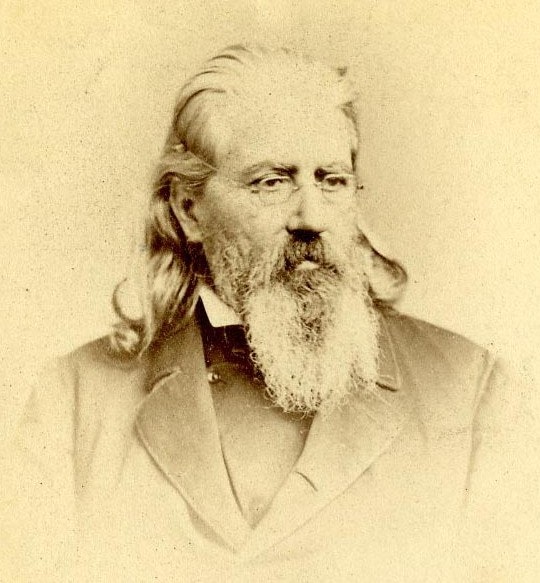 Scroll through the whole page to download all images before printing.
Scroll through the whole page to download all images before printing.Portrait of Constantine Hering, artist unknown — Source.
Hahnemann’s followers brought his model of proving to the United States in the 1830s and 40s. One of these followers was Constantine Hering, a German physician who converted to homeopathy during research for an article intended to debunk Hahemann. He fled to eastern Pennsylvania’s German immigrant community after his colleagues at the University of Wurzburg condemned him for his unorthodox turn. There, he established the Allentown Academy, a homeopathic school, and published the first American homeopathic domestic health guide; he would go on to found the Hahnemann Medical College in Philadelphia in 1848.
Hering was also instrumental in organizing a new version of Hahnemann’s Provers’ Union, promoting the same rigorous, systematic project of self-observation among American homeopaths. The American Provers’ Union emerged from a meeting at Hering’s Pennsylvania home in August of 1853. Its organization was quite ambitious: the eleven founding physicians appointed correspondents for every region from New York to Bavaria to Madagascar, so that the American provers could keep abreast of international developments. In a curious imperial metaphor, the Union’s founders describe medical knowledge as “an immense empire which is our dominion,” with the practice of proving analogous to “exploring expeditions” by which homeopaths would annex “territory after territory . . . and state after state.”4
The concept of a union was particularly important for a medical sect as embattled as the homeopaths: they wanted to present a united front against critics, but were often internally divided by petty disputes over dosage and characteristics of drugs. The Union would resolve such “reproachable animosities . . . without our injuring each other and the common cause.”5 Some homeopaths, the founding provers complained, were too absorbed in making money from lucrative practices to contribute their time to proving, while proving generated the knowledge capital upon which successful practice depended. The Union asked only for one proving per member per year — a modest service and a reminder of the common cause that homeopaths had entered into by rejecting conventional medical theory.
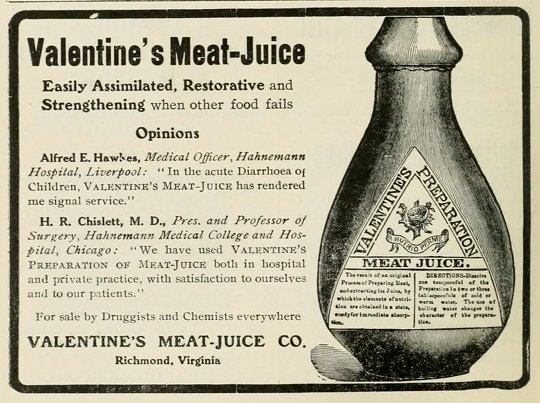 Scroll through the whole page to download all images before printing.
Scroll through the whole page to download all images before printing.An advert for a homeopathic product from a 1909 journal of the American Institute of Homeopathy — Source.
To prove, one first had to know oneself. Hering expected provers to take notes for two weeks before they began consuming their assigned remedy, so they might learn to distinguish “usual, habitual, and frequently appearing morbid symptoms, from the unusual, strange, or new symptoms.” Dosage guidelines for provers were similarly subjective: “The object of the prover is to be affected by the drug, without being poisoned, or his health seriously endangered.” Arriving at this sweet spot was largely a matter of prior experience and analogies drawn from other, similar substances. Although a successful proving required only one properly-calibrated dose, proper calibration could take many attempts. The founding provers warned against increasing one’s dosage steadily for more than a week, as “many symptoms may be caused by the drug but remain latent for a while, and then show themselves in a very inconvenient way.”6
Three years after it formed, the American Provers’ Union issued its first official provings for “ferrum metallicum” (iron), and “mercurius iodatus ruber” (mercury iodide), noting with some disappointment that only ninety-seven physicians of the “many thousands” in the United States had agreed to ingest these substances experimentally. Published provings follow a peculiar format, presenting a digest of symptoms organized by categories such as location in the body, time of day, periodicity, types of sensation, and physical activity. Despite the homeopaths’ emphasis on constitution and individualized response, it isn’t possible to track the set of symptoms experienced by any single prover. Traces of individuals weave in and out of the cascading descriptions:7
“The most abiding symptom was a nervous hysterical feeling . . .”
“Feels as if a dark curtain was let down over her eyes . . .”
“A throbbing pain . . . whenever he moved suddenly . . .”
Sometimes the time of day or periodic recurrence are noted: “. . . dullness in the head (8 A.M.), gradually subsiding towards night”; “Awoke at 3 A.M. with severe stitches, as from a pen-knife . . . rendering her unable to go to sleep again”; “Feverish at 3 P.M.”
We see provers having difficulty with everyday activities: “Unable to see the stitches in sewing . . .”; food “tastes like rotten eggs”; “great restlessness . . . cannot study or go through the daily duties”; “While writing, no power over the pen . . . the letters run into each other.”
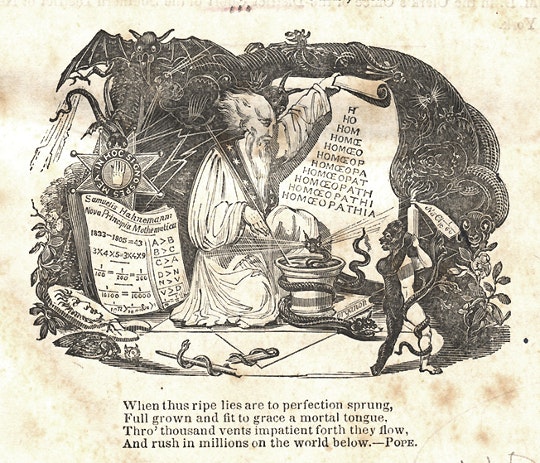 Scroll through the whole page to download all images before printing.
Scroll through the whole page to download all images before printing.Illustration from the title page of William Leo-Wolf’s Remarks on the Abracadabra of the Nineteenth Century (1835), an anti-homeopathy tract — Source.
Understanding the practice of proving requires us to set aside modern notions of toxicity; it’s impossible to know the purity and concentration of substances that provers consumed, and inadvisable to search out equivalences in today’s medical literature. Provers were trained to note the smallest minutiae of their physical and mental states, so it should not shock us greatly to find pains surfacing in every part of the body: “Slight pain in the small of the back”; “Shoulder sore to the touch”; “Slight headache all day . . .” That said, one can only shudder at symptoms like “violent pressure in stomach” and “burning and acid eructation” that suggest ulceration of the stomach lining by elemental iron.
The impulse to map these symptoms onto current biomedical understandings must ultimately yield to their strangeness. Under the category of “Female Organs,” we learn that a dose of ferrum metallicum gave one subject “Less dryness in vagina on commencing coitus, and more enjoyment of it.” Under the category “Feet,” we learn that the prover “Has to take off boots.” And more literary observations — “In the open air, tears.” We could concoct a rational physiological explanation, but we could just as easily let these experiences speak for the more expansive world in which they occurred — the “immense empire” of the human organism, with its uncharted territories and secret byways linking distant parts in furtive conspiracy.
The last frontier of the immense empire was surely dreams. These, seamlessly incorporated into the provers’ symptomatology between “Sleep” and “Waking”: “Unpleasant dreams of friends and relatives, deceased 25 years since”; “. . . dreamed a great deal of meeting with old schoolmates . . .”; “. . . much disturbed by dreams of old friends”; “Sleep disturbed by many confused dreams.”
Based on these observations, the proving concludes with remarks from Constantine Hering suggesting that ferrum metallicum may be more useful than previously thought in the treatment of bronchitis, catarrh, and certain skin diseases.
The proving of mercury iodide, published in the same volume, looks similar to ferrous metallicum with the addition of much unwelcome drooling. This text represented a great accomplishment for American homeopaths, who could claim an important contribution to their profession’s understanding of standard materia medica. Due, however, to the dearth of participants frequently remarked by Hering and his compatriots, it took another three years for the Union to complete its next published proving.
Another plausible reason for the delay is that the Provers’ Union was testing cannabis indica, a variety of pot known today for producing an even-keel “mellow” sensation rather than a hallucinatory or ecstatic high. Provers reported “disinclination to physical labor,” “excessive sleepiness,” “sound sleep with melancholy dreams.” Hashish being widely recognized for its dubious moral effects, moral symptoms received special consideration, and included “great anguish and despair,” “tendency to blaspheme,” and “laugh[ing] immoderately.” As always, there were some bad trips: “[he] fancies, upon opening his bedroom door, that he sees numberless diabolical imps . . . he thinks he will suffocate . . . suddenly, one of the imps begins playing on a hand-organ . . .” Other hazards: “Constantly theorizing”; bloodshot eyes; “ravenous hunger, which is not decreased by eating enormously,” “excessive venereal appetite with frequent erections during the day.”8
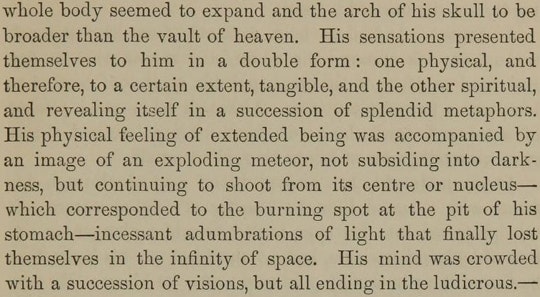 Scroll through the whole page to download all images before printing.
Scroll through the whole page to download all images before printing.Excerpt from Provings of Cannabis Indica (1859) — Source.
Although, of course, the cannabis was taken as a tincture, and its concentration is unknown, some provers seem to have indulged more than others. A Dr. Neidhard took fifteen drops of the tincture in total, while Dr. Wolfe took “30 to 1000 drops every day,” from May 25 to October 1, “when he had taken it all.”
This proved to be the final and rather shambling proving of Hering’s Provers’ Union. For reasons which went unrecorded, the group disbanded, with some efforts made in subsequent years to revive the project. For the most part the homeopathic materia medica survives unchanged from its early-nineteenth-century form. The problem of replication in today’s biomedical sciences bears a family resemblance to the Provers’ Union’s fate: there is little incentive for laboratories to spend their resources attempting to falsify a widely-accepted finding. For nineteen-century homeopaths, however, firsthand experience was supposed to be more valuable than received knowledge, and professional consensus was, by design, always in flux. In a remarkable passage of the Provers’ Union’s charter document, Hering and his compatriots stated that the theory of homeopathy would “receive either new support every year, or will have to be abandoned” depending on the outcome of their investigations.9
Today’s drugs are developed based on an entirely different understanding of the body, disease, and scientific method. A physician who tried them all would not fare well, and a physician who tried only the fun ones would be a drug abuser, rather than a martyr for the “welfare of suffering humanity.” Everything that a physician needs to know about drug effects is distilled through controlled trials and the regulatory approval process, bowing, as Hahnemann and Hering refused to do, to the practical necessities of a massive and ever-growing pharmacopoeia.
How nice would it be, though, to speak with a doctor who had carefully observed the effects of a drug upon his or her own body, who could tell you about the anxiety, nausea, stiffness of limbs — the precise conditions of mind and body that you may pass through in hope of a cure. “Our acquaintance with drugs and their effects, is like our acquaintance with men,” Hering and company wrote in 1853. “We are intimate with a few, we like the company of several men, we are glad to see a great many others now and then . . . there are a great many degrees of intimacy, according to the events of our life. . . It is the same with our instruments of healing, our medicines.”10
Alicia Puglionesi is a writer and historian. She holds a PhD in the History of Science, Medicine, and Technology from Johns Hopkins University. Her first book, Common Phantoms: An American History of Psychic Science (2020), explores how the practices of seances, clairvoyance, and telepathy both questioned and reinscribed social boundaries. Her second book, In Whose Ruins: Power, Possession, and the Landscapes of American Empire (2022), examines four sites of resource extraction that also yielded scientific and spiritual narratives core to US settler-colonialism. Her essays from various corners of the web can be found here.







